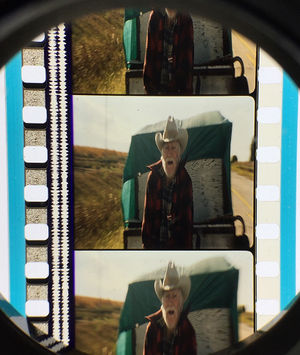| Welcome to Sprocket School! This project is maintained by volunteer editors. Learn more about how this works. |
Dolby SR-D: Difference between revisions
No edit summary |
No edit summary |
||
| (4 intermediate revisions by 3 users not shown) | |||
| Line 1: | Line 1: | ||
'''Dolby SR-D''', also called '''Dolby Digital''' is an optical digital format introduced in 1992. | '''Dolby SR-D''', also called '''Dolby Digital''' is an optical digital format introduced in 1992. Nearly all prints with Dolby Digital tracks also have [[Dolby SR|SR]] tracks. | ||
SR-D is encoded with six discrete channels of digital sound: Left, Center, Right, Left Surround, Right Surround, and Subwoofer. SR-D EX offers a seventh, "Rear-Surround" channel which is matrix encoded into the Left and Right Surround channels. | SR-D is encoded with six discrete channels of digital sound: Left, Center, Right, Left Surround, Right Surround, and Subwoofer. SR-D EX offers a seventh, "Rear-Surround" channel which is matrix encoded into the Left and Right Surround channels. | ||
| Line 12: | Line 12: | ||
When inspecting an SR-D print, it is advisable to occasionally look at the SR-D soundtrack with a loupe for any thick base or emulsion scratches. If there is excessive wear on the SR-D track, you should keep a close eye on the track during playback and watch for dropouts. If the SR-D track is constantly failing (reading "F" on the processor) because the signal quality is too poor, the processor will revert to Dolby SR. The change in sound quality from SRD to SR is very apparent, so if the film is constantly switching between SRD and SR it is preferable to switch the sound format to SR and leave it in that format. | When inspecting an SR-D print, it is advisable to occasionally look at the SR-D soundtrack with a loupe for any thick base or emulsion scratches. If there is excessive wear on the SR-D track, you should keep a close eye on the track during playback and watch for dropouts. If the SR-D track is constantly failing (reading "F" on the processor) because the signal quality is too poor, the processor will revert to Dolby SR. The change in sound quality from SRD to SR is very apparent, so if the film is constantly switching between SRD and SR it is preferable to switch the sound format to SR and leave it in that format. | ||
[[File:SRD_Misprint.jpeg |left|thumb|300px|An example of a misprinted SR-D track. An SR-D reader will not be able to read this!]] | |||
| Line 17: | Line 19: | ||
* Wikipedia: [[http://en.wikipedia.org/wiki/Dolby_Digital Dolby Digital]] | * Wikipedia: [[http://en.wikipedia.org/wiki/Dolby_Digital Dolby Digital]] | ||
[[Category:Sound formats]] | [[Category:Sound formats]] | ||
[[Category:Sound]] | [[Category:Sound]] | ||
Latest revision as of 11:52, 4 October 2017
Dolby SR-D, also called Dolby Digital is an optical digital format introduced in 1992. Nearly all prints with Dolby Digital tracks also have SR tracks.
SR-D is encoded with six discrete channels of digital sound: Left, Center, Right, Left Surround, Right Surround, and Subwoofer. SR-D EX offers a seventh, "Rear-Surround" channel which is matrix encoded into the Left and Right Surround channels.
A nice explanation of SR-D EX here: http://www.dolby.com/us/en/consumer/technology/movie/dolby-digital-surround-ex.html
See the Dolby Cp-650 Manual Appendix D, Pg 33-35 for an explanation of all dolby formats: http://www.film-tech.com/warehouse/manuals/DOLBYCP650USER.pdf
The first feature film released in Dolby Digital was Batman Returns (1992)
Dolby SRD is easily distinguishable from Mono, Dolby SR, and Dolby A since the digital information looks like a cloud of dots between the sprockets. Because the sound data resides on a part of the film that touches the gears and rollers during the projection, the quality of the digital signal can quickly deteriorate if the film path is not kept perfectly clean, or if excess gate tension is applied to the print. That said, the Dolby Digital soundtrack is designed to survive several hundred plays with outstanding results.
When inspecting an SR-D print, it is advisable to occasionally look at the SR-D soundtrack with a loupe for any thick base or emulsion scratches. If there is excessive wear on the SR-D track, you should keep a close eye on the track during playback and watch for dropouts. If the SR-D track is constantly failing (reading "F" on the processor) because the signal quality is too poor, the processor will revert to Dolby SR. The change in sound quality from SRD to SR is very apparent, so if the film is constantly switching between SRD and SR it is preferable to switch the sound format to SR and leave it in that format.

External Links
- Wikipedia: [Dolby Digital]